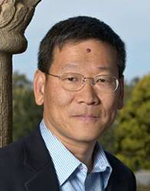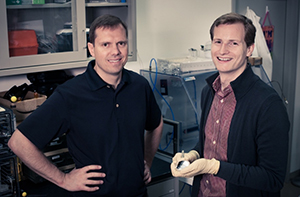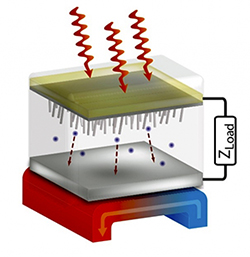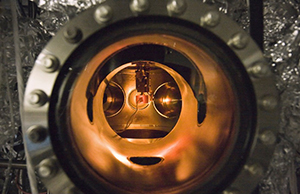

 |
 |
|
|||||||||||||
 GCEP Quarterly Newsletter
Newsletter Sign-Up
News Archive
GCEP Quarterly Newsletter
Newsletter Sign-Up
News Archive
|
Video: SLAC National Accelerator Laboratory
Stanford graduate student Jared Schwede explains how PETE technology harvests electricity from waste heat.
By Mark Shwartz In 2008, a Stanford University research team received GCEP funding to test a novel idea for a solar device that uses both light and heat from the sun to generate electricity. Lead scientists Nick Melosh and Z-X. Shen, together with doctoral student Jared Schwede, called their new technology "photon-enhanced thermionic emission," or PETE. Conventional silicon solar cells use a semiconductor that converts sunlight to electricity. However, only the infrared waves of sunlight that match a characteristic energy of the semiconductor can be converted efficiently. Lower energy light, and higher-energy light waves, including most of the visible light spectrum, are wasted as heat. As a result, silicon solar cells have a fundamental conversion-efficiency limit of about 30 percent. 
Z-X Shen 
Nick Melosh (left), associate professor of materials science and engineering, and graduate student Jared Schwede. (Credit: Brad Plummer/SLAC) PETE, on the other hand, uses a semiconductor made of materials that harness the entire solar spectrum. When the sun heats the semiconductor cathode to about 400 degrees Celsius (750 degrees F), high-energy electrons are released – the so-called "thermionic effect." Some of these hot electrons are then funneled to the semiconductor anode and converted to electricity instead of dissipating as waste heat. Additional heat energy is collected below the anode and used to run a turbine or an engine that generates additional electricity. In theory, PETE could more than double the efficiency of a conventional photovoltaic cell, according to Melosh, Shen and Schwede. But the scientists had to demonstrate that it was more than an abstract concept. GCEP support allowed them to do just that. In 2010, the journal Nature Materials published a GCEP-funded study by the Stanford team showing that it is indeed possible to combine solar photovoltaic and thermal technologies into a single device. 
Concentrated sunlight (red arrows at the top) heats up the device's semiconductor cathode (beige and grey upper plate) to more than 400oC. Photoexcited hot electrons (blue dots) stream out of the cathode's nanotextured underside down to the anode (white/gray surface), where they are collected as direct electrical current. Additional solar and device heat is collected below the anode (arrow shows the cool-to-hot, blue-to-red flow) to run electricity-generating steam turbines or Stirling engines. (Courtesy: Nick Melosh)
The success of that proof-of-concept experiment led to an additional exploratory research grant from GCEP and significant follow-on funding from the Gordon and Betty Moore Foundation and the U.S. Department of Energy. By 2013, the Stanford team had developed a PETE device capable of converting sunlight and solar heat into electricity with 2 percent efficiency – 100 times more efficient than the prototype they had built in 2010. "What we've demonstrated is a new physical process that is not based on standard photovoltaic mechanisms, but can give you a photovoltaic-like response at very high temperatures," said Melosh, an associate professor of materials science and engineering. "In fact, it works better at higher temperatures. The higher the better." The Stanford team is currently exploring new materials that could greatly enhance the efficiency and stability of PETE devices. A long-term goal is to couple a PETE photovoltaic device with a grid-scale concentrating solar power plant (CSP), which converts solar heat to electricity. 
A small PETE device made with cesium-coated gallium nitride glows while being tested inside an ultra-high vacuum chamber. The tests proved that the process simultaneously converted light and heat energy into electrical current. (Courtesy: Nick Melosh) The idea has also captured the imagination of scientists worldwide. In 2013, the European Union launched Prometheus, a three-year, 4.2 million euro ($5.7M) project to support research that advances PETE technology for use with large-scale CSPs. The Prometheus consortium is coordinated by the Italian National Research Council and includes scientists from Tel Aviv University, the Israel Institute of Technology (Technion), the Fraunhofer Institute in Germany and several European renewable energy companies. And on June 23-24, 2014, Tel Aviv University hosts PETE-2014, the first International Workshop on Photon-Enhanced Thermionic Emission with scientists from Europe, Israel and the United States, including Stanford’s Melosh and Schwede. In just five years, what began as a novel idea has evolved into an international scientific field of research. "All in all, the GCEP funding launched a new area in solar conversion, and it’s just starting to really take off," said Melosh. "The initial support from GCEP was very critical," added Shen, the Paul Pigott Professor in Physical Sciences at Stanford. "PETE was originally treated as a curiosity, but GCEP was willing to take a high-risk idea and give it a shot. Something that started here has now flourished into a discipline recognized around the world. It has been a pretty exciting journey for us." Mark Shwartz writes about energy technology for the Precourt Institute for Energy at Stanford University. June 12, 2014 |
| Restricted Use of Materials from GCEP Site: User may download materials from GCEP site only for User's own personal, non-commercial use. User may not otherwise copy, reproduce, retransmit, distribute, publish, commercially exploit or otherwise transfer any material without obtaining prior GCEP or author approval. |